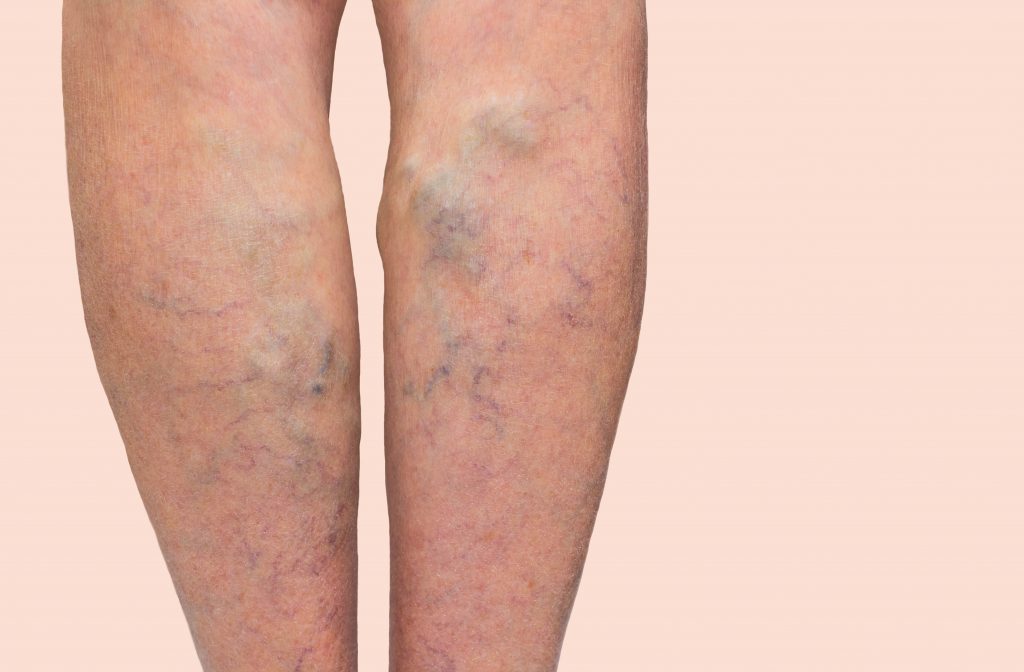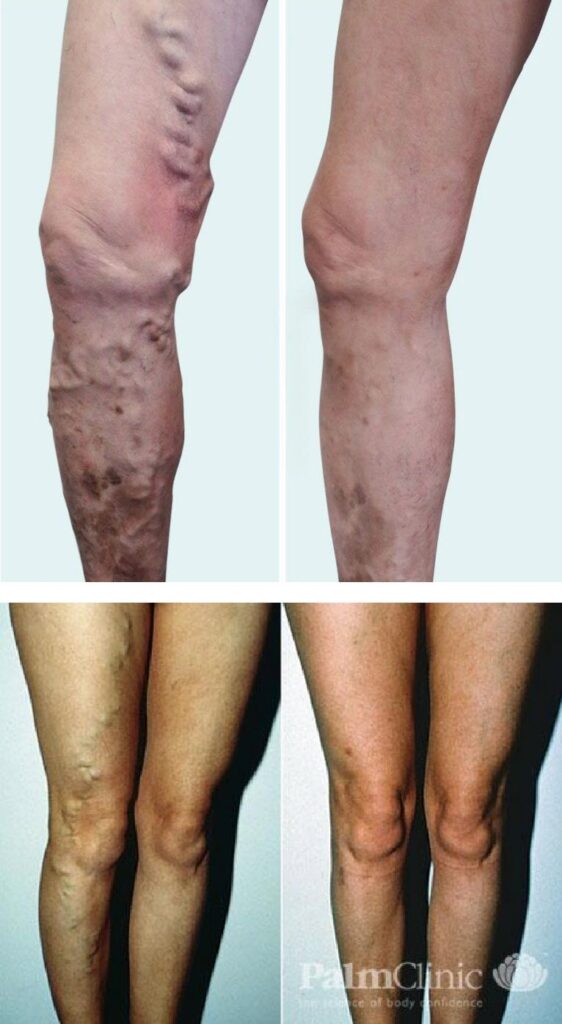Varicose Veins – Causes, Symptoms, Removal & Treatments – Auckland NZ
Varicose veins are swollen veins in the legs which can be visible on the surface of the skin or hidden beneath. They don’t always cause discomfort but many people experience aching, heaviness or swelling in their legs and ankles. You don’t need a GP referral to seek treatment in our Auckland clinic.
Here we explain the causes of varicose veins, varicose veins symptoms, varicose veins prevention, and varicose veins treatments including before and after treatment photos.
What Causes Varicose Veins
Normal vein function relies on the vein walls and valves maintaining their elasticity. If the wall or valve becomes damaged or weak, the vein becomes less effective at doing its job, which is to direct blood flow up the leg to the heart.
Rather than blood flow being directed towards the heart, it flows backwards towards the feet where it pools in the veins. This is a condition called venous insufficiency and it is what causes the leg vein to enlargen or become “varicose”.
There are many factors that contribute to venous insufficiency and varicose veins. These can be genetic, age and gender-based, or to do with general health and lifestyle:
If anyone in your immediate family has varicose veins, there is a good chance that you can expect to develop them. If one parent has varicose veins, you have around a 40% chance of developing them, if both parents have them your chance rises to around 90%.
Another key factor is age. Varicose veins are common in adults, with studies suggesting that up to 30% of adults have them. As with most things, the veins walls and valves are subject to the wear and tear of ageing, which can make them less effective over the years.
Women are more prone to developing varicose veins. It is thought that oestrogen softens the vein walls and valves, which can cause them to stretch and become less functional over time. Pregnancy can also cause or worsen varicose veins as the increase in blood volume and abdominal pressure that comes with pregnancy puts additional pressure on the leg veins.
Likewise, obesity is another common cause of varicose veins.
Working in an occupation that requires a lot of time on your feet can also contribute to varicose veins, such as hairdressers, chefs, retail and factory workers. This is because long periods of standing places additional strain on the veins, which causes additional wear and tear over time.
Varicose Veins Symptoms
While some people don’t experience any symptoms from having varicose veins, it’s not uncommon to experience heavy, tired, aching legs and swollen ankles. These symptoms are more likely to occur after prolonged sitting or standing, and are usually worse at the end of the day.

Spider veins can also be associated with varicose veins. These are small versions of varicose veins and appear as very fine thread-like veins on the surface of the skin, often en masse to resemble a spider’s web.
If left untreated, varicose veins get worse over time and can cause additional health concerns such as varicose ulcers. They may also cause dark pigment forming on the lower legs or a congested purple appearance of the feet at the end of the day.
Another complication of venous insufficiency – in addition to venous eczema and venous ulcers – is a clot in the leg veins known as deep vein thrombosis or DVT. While this isn’t a direct symptom of varicose veins, it is an associated health concern to be aware of.
Varicose Veins Removal and Treatment
Varicose veins removal through surgery is no longer considered the leading treatment option. At Palm Clinic we have introduced to NZ the best modern varicose veins treatment options, which are non-surgical procedures that cause minimal discomfort and no scarring.

The industry-leading varicose veins treatments that we provide in Auckland, NZ are:
Radio Frequency Ablation (RFA): RFA is proven to be the most effective method for treating varicose veins as it provides the longest lasting results and causes the least discomfort. It is therefore our primary treatment recommendation.
RFA uses radiofrequency energy to close off or “ablate” the affected vein. Once closed off, the vein will no longer carry blood, so swelling and other symptoms will be alleviated and it will cease to be visible or bulbous on the surface of the skin. Read more.
Ultrasound Guided Sclerotherapy (UGS): This technique was pioneered 20 years ago in NZ by Palm Clinic’s founder, Dr. John Barrett. It is globally recognised as the best option for treating varicose veins when RFA is not appropriate. It involves using an ultrasound to guide small injections of a solution called sclerosant into the affected vein. This causes the vein to close down and halts blood flow through the vein. Once closed down, the vein will no longer be swollen so symptoms will be alleviated and the vein will no longer be visible on the leg. Read more.
Endovenous Laser Ablation (EVLA): Palm Clinic has used EVLA in the past for varicose veins. It remains a very effective technique but has recently been superceded by Radio Frequency Ablation (RFA) which is proven to deliver longer lasting results with less discomfort. Read more.
Varicose Veins Prevention
Unfortunately there is no guaranteed way to completely prevent varicose veins. Generally though, the things that relieve your varicose veins symptoms can also help prevent new ones from forming. These include:
• Maintaining a healthy weight
• Exercising regularly but avoiding excess straining such as doing squats
• Avoiding long periods of standing
• Wearing compression stockings
• Elevating your legs at the end of the day
• Avoiding wearing high heels regularly
Varicose Veins Before and After Photos
View our gallery of varicose veins pictures showing before and after treatment at Palm Clinic.
Vein care for confidence and comfort at every step.
New Zealand’s Busiest Varicose Vein Clinic
Dr John Barrett, the founder of Palm Clinic in Auckland, introduced Ultrasound Guided Sclerotherapy to New Zealand in 1998 and was one of the first exponents of Endovenous Laser Ablation for varicose vein treatments in New Zealand. We now have a team of phlebologists led by Dr Sam Dunn at Palm Clinic in Auckland which is the busiest Vein Clinic in New Zealand. Palm Clinic has performed over 7000 laser treatments for varicose veins and more than ten thousand ultrasound guided sclerotherapy procedures.
Varicose Vein Treatment Process
Initial consultation
With one of Palm Clinic’s Phlebologists (vein doctors). He/she will assess your varicose veins and recommend whether treatment is required. Varicose vein treatment options include: a definitive treatment such as radiofrequency ablation and/or ultrasound guided sclerotherapy or a conservative approach if treatment is not warranted, such as wearing compression hosiery.
Ultrasound Mapping
An ultrasound of your varicose veins will be performed at Palm Clinic by a vascular sonographer and a “map” of your veins will be created. This will be assessed by your Palm Clinic Doctor and a varicose vein treatment plan, optimised for you, will be formulated. You will then book for the relevant treatment sessions at a time that suits you.
Treatment Plan
An information folder will be given to you with copies of the treatment plan, possible risks and side effects, requirements for post treatment care and a quote. We have this information in French and Mandarin if required.
Medical Insurance for Varicose Veins
Palm Clinic is an affiliated provider to Southern Cross for varicose veins and a First Choice Provider for NIB. Medical necessity criteria apply.
For Southern Cross and NIB you do not need prior approval. Palm Clinic is able to authorise this online if you bring your member number. Varicose vein treatments are generally covered by other medical insurers such as Sovereign, Unimed and others when meeting ‘medical necessity criteria’.

Pain free legs our patients are proud to show off.
At Palm Clinic, you won’t have to keep suffering from painful, achy and unsightly Varicose Veins when the solution can be simple. We will provide you with effective non-surgical treatment that will help to give you back pain free legs you’ll be proud to show off.
Vein Treatment Video
The Palm Clinic vein treatment/pre-appointment video introduces you to the Palm Clinic veins team, explains what to expect during treatment, what you need to do to prepare for treatment, post-treatment instructions for when you get home as well as potential side effects.
FAQ
Although varicose veins are not a life-threatening condition, most people with symptoms (such as aching) notice an increased quality of life after vein treatment. Or if you are symptom-free but dislike the appearance of the veins, you may choose treatment for cosmetic reasons.
For more serious complications such as varicose eczema or varicose ulcers it would be wise to have the varicose veins treated in order to improve the eczema or ulcers.
If you have ankle swelling caused by varicose veins it is sensible to treat the varicose veins as this will often improve the swelling.
The two main treatments are Ultrasound Guided Sclerotherapy (UGS), and Radio Frequency Ablation (RFA). You can find out more about these two procedures above – but generally speaking, UGS tends to be used for smaller, twisted veins; while RFA is used for larger, straighter veins. RFA is considered the gold-standard approach to treat Varicose Veins currently. Surgical stripping is an option but this is not considered the gold-standard due to increased risk and recovery time compared to RFA.
As the first step in your varicose vein treatment, we will take a vein map of your leg using ultrasound. This will help us plan the most effective and safest treatment for you.
One of the advantages of non-surgical treatment is that there’s no ‘down time’, other than the actual treatment session. You can get back to your normal routine virtually straight away. There are some exceptions – such as playing sport, heavy lifting and flying. You’ll be given easy-to-follow instructions for your post-treatment care. Those whose work involves repeated heavy lifting (>10Kg) will need to be on light duties for two weeks.
We will give you a cost estimate at the initial consultation depending on the extent of the problem and what treatment will be best for you. Check with your medical insurance provider, to see if they will cover the cost. (Palm Clinic is an affiliated Provider to Southern Cross Healthcare, and a First Choice Provider to NIB Medical Insurance). If you don’t have health insurance, or your treatment is not medically necessary, you may wish to pay for the treatment yourself.
It’s a good idea to discuss any future treatment with your GP. However you do not need a referral to visit Palm Clinic – you can make an appointment directly with us. We will always write to your GP advising our management recommendations.
After the initial consultation where your Palm Clinic vein physician will examine your varicose veins you will then proceed to an ultrasound mapping of your deep and superficial veins which will provide an accurate diagnosis and help to define the best technique for your treatment.



